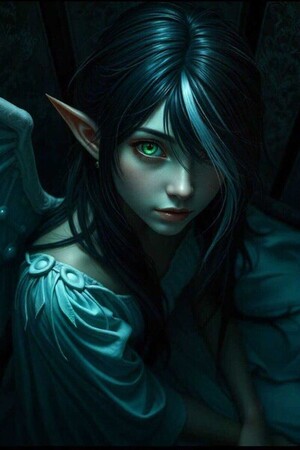Chapter 1:
The Mirror's Echo
The Mirror’s Soul
The rain fell gently over Kyoto, shrouding the city in a silver mist. Isao Tanaka pulled up the collar of his jacket and quickened his pace through the narrow streets of Gion. The damp air clung to his black hair, but he paid it no mind. Rainy days revealed a particular kind of beauty — a diffused light that transformed the ancient city into a vibrant painting, as if signed by Claude Monet.
A professional photographer, Isao had developed a unique sensitivity to light. Since high school, his talent had set him apart. At just sixteen, he had won first prize in the national photography competition with a striking portrait of an old woman at the Nishiki market, where every wrinkle on her face seemed to tell a story. Since then, awards had accumulated in his studio, silent witnesses to a gaze that knew how to capture the very essence of things.
Though digital technology had revolutionized his art, Isao often turned his attention to the past. Wet plate collodion photography, that ancestral 19th-century technique, had become his consuming passion. The imperfections of glass plates, the intricate chemical ritual, the anxious wait during development — all of it irresistibly drew him in. He loved that fragile alchemy, where light transformed into matter, where a fleeting moment became eternity.
"This technique allows us to see beyond the visible," he often told clients who marveled at his devotion to such a painstaking method. "It reveals the soul of the subject, not just their appearance."
This pursuit was what had led him to wander through the antique shops of Gion that day. He was searching for period objects — old lenses, glass plates, photographic cases — that might enrich his collection and experiments. Most antique dealers already knew him, accustomed to his regular visits, his precise questions, and his trained eye, which detected value where others saw only relics.
A storefront suddenly caught his attention. Nestled between a tea merchant and a kimono shop, a boutique he had never noticed before seemed to be calling out to him. A weathered wooden sign bore the simple inscription "Echoes from Another Place" in faded Japanese characters. The dusty display window, cluttered with a haphazard assortment of objects, hinted at treasures from another time.
Isao pushed open the door, setting off the chime of a cracked bell. The interior was dimly lit, dust particles swirling in the faint shafts of light that pierced the darkness. The scent of aged wood and incense mingled with the acrid smell of oxidized metal and yellowed paper. Shelves overflowed with objects from every corner of the world — African statuettes, Chinese porcelain, European pocket watches, old navigation compasses.
"Irrashaimase," murmured a voice, making Isao start.
An elderly woman emerged from the back of the shop. Her face, wrinkled like a winter apple, lit up with a smile, but her dark eyes remained sharp, scrutinizing. She wore a faded blue silk kimono, and her gray hair was pulled into a tight bun.
"I’ve never seen you here before, young man," she observed attentively.
"This is the first time I’ve noticed your shop," Isao replied, inclining his head slightly out of respect. "I’m looking for antique photography equipment, particularly anything related to wet plate collodion photography."
The old woman nodded, her eyes glinting with interest.
"Oh… an artist of glass and light… Interesting. I don’t have much photographic equipment, but perhaps I have something that might interest you."
She led him through the labyrinth of objects to a small alcove. A few antique cameras were displayed there, along with colored glass bottles that had once held chemical solutions. Isao examined a well-preserved daguerreotype with interest, but nothing quite matched what he was looking for.
He was about to thank her politely and take his leave when something caught his eye in the back of the shop — a glimmer of light reflecting off an object hidden behind a half-folded Chinese screen.
An ornate Victorian mirror stood there, unlike anything Japanese.
"And that?" he asked, intrigued.
The antique dealer followed his gaze, and her expression changed almost imperceptibly. A shadow crossed her face.
"That is not for sale," she said at first, then hesitated. "At least… it is not an object I would recommend."
Isao stepped closer, fascinated. The frame, made of dark wood streaked with reddish veins, was carved with intricate patterns — leaves, flowers, and what seemed to be faces half-hidden in the golden foliage. The glass itself was remarkably clear for its age, with only a few spots of oxidation in the corners. Its subtly rippled surface attested to its antiquity.
"It’s magnificent," Isao murmured. "The glass must be of excellent quality. Perfect for my refraction experiments."
The old woman stepped closer too, her movements hesitant.
"It comes from France. An object tied to a noble family, so they say."
She paused, as if weighing her words.
"There is a curse attached to it," she added in a low voice. "A story of a vanished young woman and an artist mad with love."
Isao offered a polite smile. He respected traditions and beliefs, but his mind was fundamentally pragmatic, shaped by scientific observation and the technical precision of his art.
"All antiques have their stories," he said diplomatically. "That’s what gives them character."
He examined the mirror’s surface more closely, appreciating the quality of the silvering and the way it caught the light. For his collodion experiments, such a mirror would be perfect — far superior to the modern reflectors he usually used.
"How much do you want for it?"
The old woman hesitated once more, then sighed.
"If you are truly determined… But know that I have warned you."
She named a surprisingly low price for an object of such quality, as if she were relieved to be rid of it. Isao attempted to negotiate out of habit, but his heart wasn’t in it — he already knew the mirror would come home with him.
Half an hour later, after struggling to fit the mirror into a taxi, Isao arrived at his studio on the top floor of a converted industrial building in the Yanaka district. A vast, luminous space with exposed brick walls and large windows. The rain had stopped, but the sky remained heavy with clouds.
His workspace was a reflection of his personality — a harmonious blend of tradition and modernity. A high-powered computer sat beside vintage cameras. High-precision digital prints hung next to handcrafted cyanotypes. In one alcove, his darkroom awaited, bathed in the red glow of a safety lamp.
Isao placed the mirror against a wall, between a large window and his shooting area. Positioning it took several tries — it was heavier than it seemed, as if the wood had absorbed years of humidity.
Once satisfied with its placement, he stepped back to observe the effect. The mirror completely transformed the atmosphere of the studio. Its imposing presence drew the eye, creating an unexpected focal point in the otherwise technical space.
The rest of the day passed quickly. Isao had commissions to complete — a fashion magazine wanted a special Kyoto-themed shoot, and a family had hired him for portraits of their centenarian grandmother. He became absorbed in his work, nearly forgetting his new acquisition.
It wasn’t until nightfall, as he put away his equipment, that his attention returned to the mirror. With the deepening darkness and the warm glow of the studio lamps, the glass seemed to come alive in an unusual way.
Isao stepped closer, intrigued. For a brief moment — so fleeting he thought he had imagined it — he saw something other than his own reflection. A feminine silhouette, perhaps, or simply a trick of the shadows cast by the furniture? He touched the cold surface of the mirror, which vibrated slightly under his fingers.
"An optical illusion," he murmured to himself.
Yet, as he switched off the lights before leaving, he couldn’t help but steal one last glance at the mirror. In the darkness, unusual reflections flickered across its surface — like silver fireflies, fragments of a light with no discernible source.
Closing the door to his studio, he felt a slight shiver. Was it the old woman’s words lingering in his mind? He shook his head.
Tomorrow, in daylight, he would begin his photographic experiments. Science and art would dispel the shadows of superstition.
But that night, in his small apartment next to the studio, his dreams were filled with blurred images and whispers in a language he did not understand.




Please sign in to leave a comment.